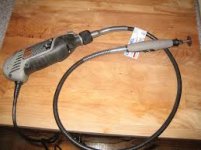I have discovered that the valve on the cold water supply line into the water heater on my Prowler 29P RKS was frozen. No water supply to tank. Unfortunately, everything is plumbed using PEX. In order to access the valve, I had to cut the PEX and remove the valve and the 90 degree elbow connection that goes to the back of the water heater. What I'm left with is a 'T' with one leg being the cold water in, one being the bypass branch with a valve in it, and the third being the remaining stub of PEX where I cut the line. I'm trying to figure out how I can remove the remaining bit of PEX and the crimping ring that holds in on the T. I had to saw off the crimp rings with a hack saw on the section that I cut away, but I could do that because they were no longer in the trailer. For the remaining piece still attached to the T, there's no room to get to the crimp ring on the T. They make special PEX de-crimping tools, but they require that part of the tool be inserted in the fitting. In this case the fitting (T), is plastic and I'm afraid the tool will crack the fitting which means I now have to replace the fitting which in turn necessitates removal of 2 more crimp rings. I might be able to do it if I pulled the HW heater out of the trailer, but I really don't want to mess with that. If I can get the remaining PEX off the T fitting, I'm just going to use regular clear water line and hose clamps to run from T to new valve to tank, so if I have to do something like this again it will be less hassle.
The T fitting is designed to be used with PEX. When I fit a piece of regular 1/2 in. ID water line (clear reinforced rubber line from Home Depot) onto it, it seems a bit loose. I think it would be okay with a properly tightened hose clamp or maybe 2.
My questions are:
Has anybody done this type of repair before and if so, how did you get the crimp ring(s) off the PEX still inside the compartment behind the HW heater? There is very little room to work.
Has anybody used a PEX decrimping tool on a plastic fitting, and if so did it cause it to crack?
Has anybody replace the PEX tube with regular rubber reinforced supply lines and hose clamps, and if so, were there any leaks between the rubber line and the PEX T fitting or did the hose clamp(s) seal it up okay?
Thanks.
The T fitting is designed to be used with PEX. When I fit a piece of regular 1/2 in. ID water line (clear reinforced rubber line from Home Depot) onto it, it seems a bit loose. I think it would be okay with a properly tightened hose clamp or maybe 2.
My questions are:
Has anybody done this type of repair before and if so, how did you get the crimp ring(s) off the PEX still inside the compartment behind the HW heater? There is very little room to work.
Has anybody used a PEX decrimping tool on a plastic fitting, and if so did it cause it to crack?
Has anybody replace the PEX tube with regular rubber reinforced supply lines and hose clamps, and if so, were there any leaks between the rubber line and the PEX T fitting or did the hose clamp(s) seal it up okay?
Thanks.

